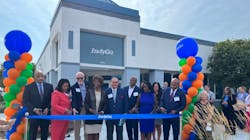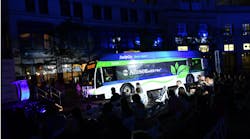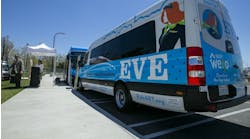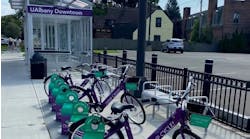The Indianapolis Public Transportation Corporation (IndyGo) hosted a ribbon-cutting ceremony on Aug. 11 to celebrate the grand opening of its new East Campus headquarters.
The 110,000-square-foot building represents the future of IndyGo, as it outgrows the current headquarters located at 1501 W. Washington St. The new location features expanded storage for the agency’s growing bus fleet, state-of-the-art training for bus drivers and more room for employees to safely work in this post-pandemic era.
One of the biggest features of the new facility is the IndyGo Academy, which will provide four state-of-the-art driving simulators programmed with scenarios specific to IndyGo, allowing bus drivers to learn new skills and maneuvers before they get on the road. The academy also includes a mock bus to train drivers on how to secure riders in mobility-assisted devices without the agency pulling a bus out of revenue service.
Other features of the new headquarters include a larger boardroom that will also be available for community groups to reserve for meetings, more collaborative spaces for employees to gather and innovate and an extended outdoor CDL training course. Additionally, it will accommodate the agency’s planned bus storage and maintenance facility. This will provide essential space for additional 40-foot hybrid and 60-foot electric vehicles, as IndyGo’s fleet continues to expand in anticipation of the upcoming bus rapid transit (BRT) route, the Purple Line.
“In moving to the Far Eastside, IndyGo is demonstrating its commitment to the community, placing its new home and headquarters where many of its employees and riders reside,” said IndyGo President and CEO Inez Evans. “As the Purple Line continues to progress toward completion, we are putting our money where our mouth is by embracing the surrounding neighborhoods we serve daily as our own. We are very excited about this new space, but it is not only our new home, but the community’s new home.”
“IndyGo’s new facility marks a huge step forward for transit in Indianapolis,” said Federal Transit Administration Administrator Nuria Fernandez, who has provided federal support for IndyGo’s BRT system and construction of the new bus storage facility. “In the short term, IndyGo’s operations will become much more efficient, but even more exciting is how the new campus will facilitate the transition to a fully zero-emission bus fleet.”
According to IndyGo, ridership is rebounding and service expansion is already underway, thanks in part to the continued implementation of the Marion County Transit Plan. The new location on the city’s Far Eastside also offers IndyGo increased operational efficiency.
More than 70 percent of the agency’s employees live on this side of the city and several routes end on the east side, meaning the eventual streamlining of service once the new bus storage facility is complete, positioning IndyGo to restore some service sooner and strategically put the agency where potential job applicants live, making IndyGo a more accessible and attractive workplace.
IndyGo’s workforce is also heading in the right direction in the wake of a recently implemented $3,000 signing bonus for successful hires as a bus driver or mechanic, in addition to the extensive list of competitive benefits. Since its launch July 1, the incentive has already shown a positive impact, increasing driver and mechanic applications and hiring. To complement the hiring incentive, IndyGo has recently hired a Community Recruitment Manager to oversee an innovative new approach to finding qualified applicants. The position was made possible by a grant from the Indianapolis African American Quality of Life Initiative.
IndyGo notes moving its headquarters to the Far Eastside also brings tremendous benefits to the community through the economic development opportunities for businesses and residents and the strengthened partnerships with stakeholders, such as the agency’s microtransit programs, paratransit and healthcare providers and more.







